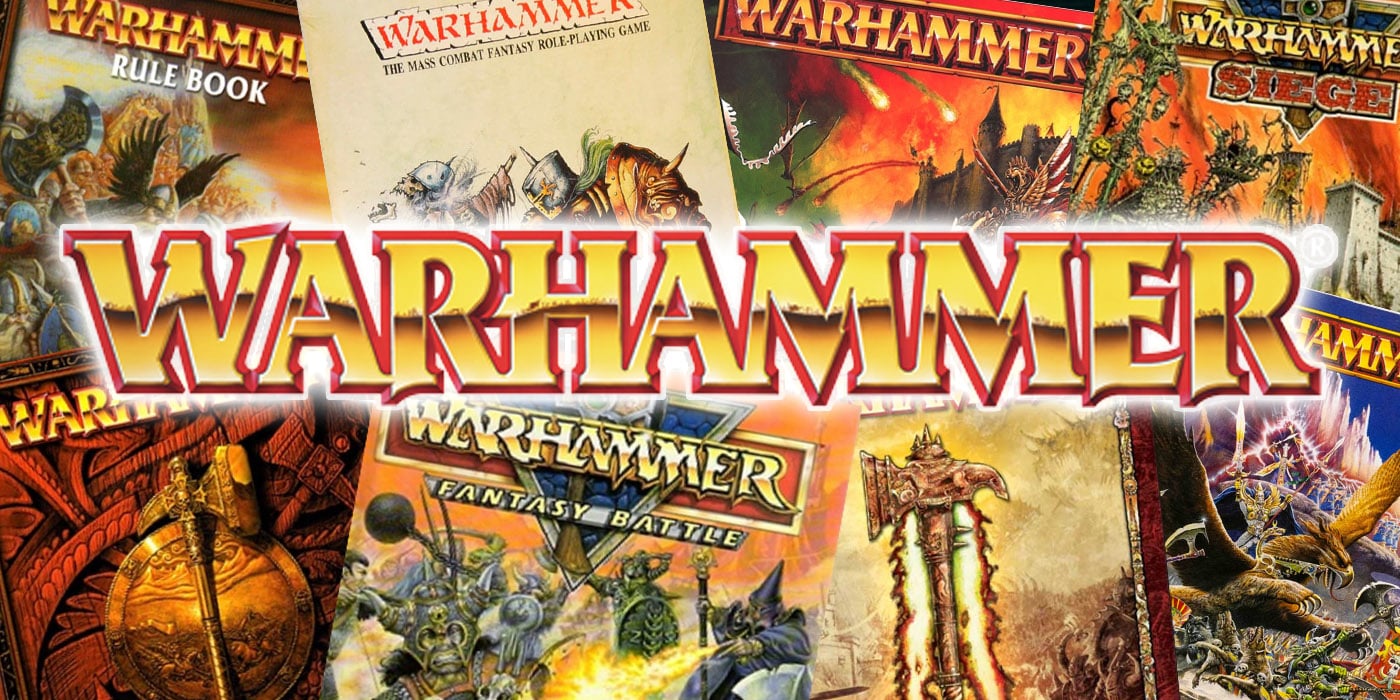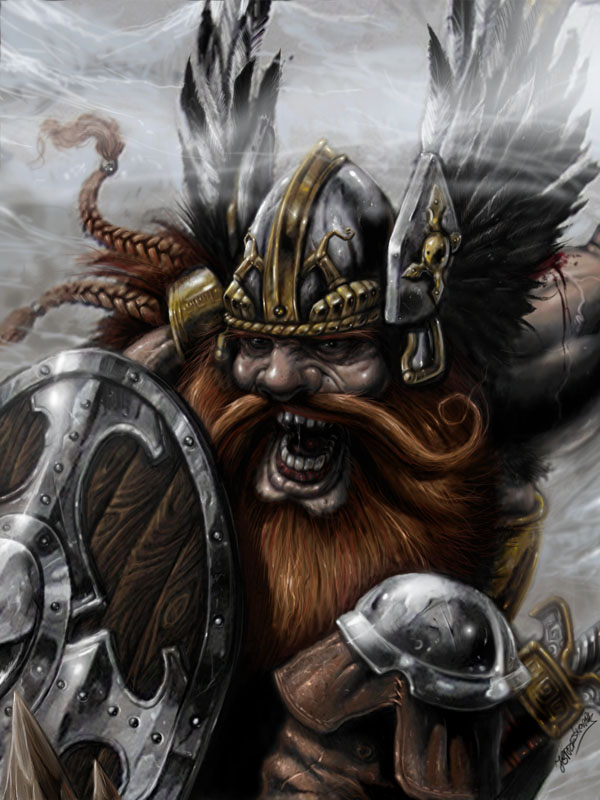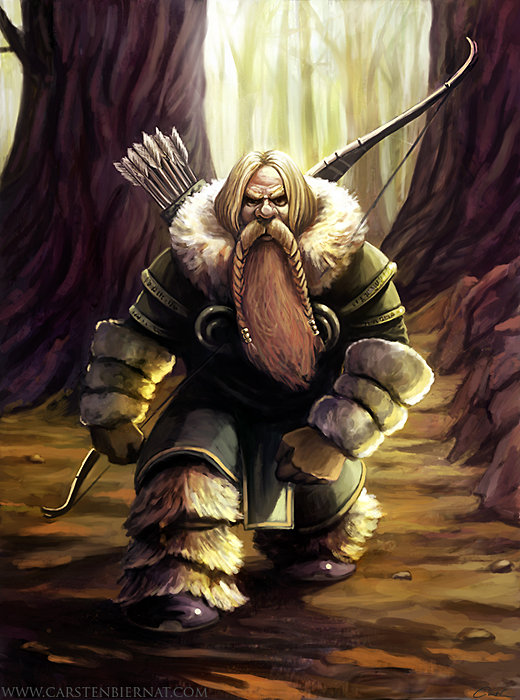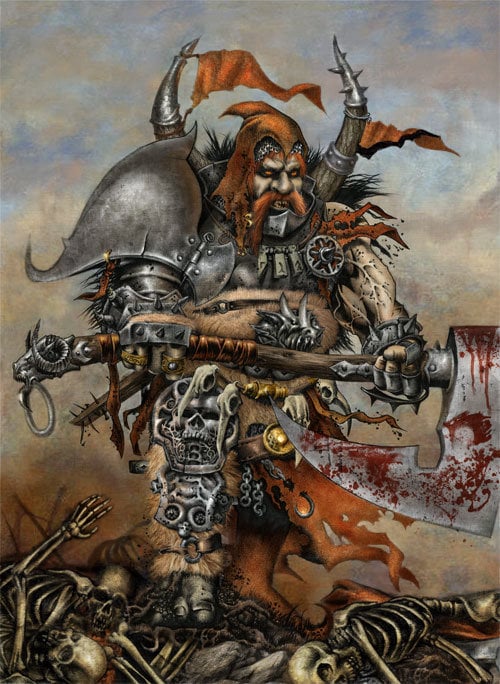WHFB Tactics: Dwarfs – Heroes

Hello there everyone, my name is Learn2Eel and welcome to my newest set of Unit Overview articles focused on the “stunties” – the mighty Dwarfs from the Warhammer Fantasy setting.
While much of the background Games Workshop employs is heavily inspired by sources such as Tolkien, their own version of Dwarfs has proven most successful by carving out their own identity and distinct traits. Whether you are a beginner or a veteran when it comes to all things small and bearded, I hope you find this a useful series and hope you enjoy it!
Heroes
Josef Bugman – The famous Josef Bugman, maker of the ale that bears his namesake, amounts to a Thane with an improved profile and lots of useful special rules that distinguish him as more of a support character than anything else. Bugman has an impressive four attacks at Strength 5 base which is certainly superior to a Dwarf Lord, especially as he shares that same Initiative value of four, while his close combat attacks are all resolved with the Armour Piercing special rule regardless of a Runesmiths’ presence. Throw in both Ancestral Grudge and Resolute and Bugman can pack quite a punch with four Strength 6 attacks on the turn he charges at Initiative 4 with Weapon Skill 6. He has above average combat capabilities for a Hero choice and even for a Lord choice before runes are taken into account, while his 3+ armour save and 6+ parry save on a Toughness 5 model with 2 Wounds makes him decently survivable by Dwarf standards – oddly enough though he lacks the Shieldwall special rule.
He packs in a Dwarf Crossbow at Ballistic Skill 5 to fit in nicely with his merry band of Rangers, providing a tiny little bit of extra punch to ranged units that other characters tend not to be well suited for. As nice as his profile and melee potential is though, Bugman packs on the value with a number of extra special rules that he confers upon his unit. Not only does Bugman provide immunity to Fear and Terror for any attached unit, but he also allows them to share his tremendously popular brew. This is resolved by rolling 2D6 at the start of all friendly turns, with the roll of ‘snake eyes’ being the only negative result – even though becoming Flammable will almost never matter seeing as only Dwarf characters have multiple wounds anyway! The most common result will be that the unit freely gains Stubborn, while rolling a ten or higher on the dice will temporarily bestow +1 Toughness on every model in the unit for a turn.
This makes Bugman particularly well suited to any unit that expects to see close combat such as Hammerers or Ironbreakers, while his special tankard can further be used to restore D3 lost wounds to a single model in the same unit at the start of any friendly turn. If you really want to make a Dwarf Lord on Shieldbearers “unkillable”, combo him up with Josef Bugman and watch as the few unsaved wounds that trickle through are quickly regenerated by the savvy brewer. When all is said and done, Bugman belongs in a main-line combat unit joined by multiple characters such as a Dwarf Lord and a Thane Battle Standard Bearer where his numerous special rules and runic items truly display their usefulness. On the other hand, Bugman is notorious for leading bands of Rangers into the thick of the fray and he subsequently has the Scout special rule to this effect.
If that wasn’t enough, an army list featuring Bugman can choose – but is not forced too, hooray for choice! – upgrade a single unit of Rangers to Bugman’s personal cohort, providing them with a +1 bonus to their Weapon Skill, Ballistic Skill and Strength stats all for a few points per model extra. This is a worthwhile upgrade as it turns Rangers into an elite shooting and combat unit that has incredible versatility in the deployment phase when contrasted against the vast majority of the Dwarf army, even if Bugman himself is forced to join them. Rangers are a great unit in the current army book and Bugman makes them so much better not only by upgrading them, but also because of what he provides to any unit he joins. Heck, having Strength 7 Rangers on the turn they charge that shoot at Ballistic Skill 4 with either throwing axes or Dwarf crossbows is good enough to justify the low cost of the master brewer, but then you remember that he is also a good fighter, hardy and generally just an awesome all round choice.
Competitive? Yes.
Grimm Burloksson – Priced identically to the incredibly valuable Josef Bugman is another new special character for the Dwarf army, the unique Master Engineer known as Grimm Burloksson. While his profile only has two differences from that of a standard Master Engineer – namely that he has two Strength 6 attacks and an improved Ballistic Skill 5 – Grimm offers Dwarf players yet another excuse to field a gunline or hybrid build with his awesome support capabilities. Grimm features two of the three usual special rules that give a Master Engineer his identity, namely Entrenchment and “Stand Back Sir”. Not only does he provide a hard cover bonus alongside a 1 to hit penalty in combat against a friendly war machine, Burloksson can also benefit from the Look Out Sir special rule from a Dwarf war machine exactly as if he were a character within 3″ of a regiment of the same unit type. Where Grimm differs is in how he actually buffs a war machine’s shooting effectiveness as he has his own unique “Master of Accuracy” special rule which is awesome if only because it isn’t restricted just to war machines. While this special rule does require that a D6 roll of a 2+ be completed at the start of a friendly shooting phase for it to take effect, the lack of downside for rolling a 1 and increased range of effects provided over a Master Engineer’s Artillery Master special rule make it one heck of a valuable addition to the sage’s arsenal.
While he can still provide that same re-roll on the artillery dice in addition to using his Ballistic Skill 5 for one war machine – he is perfect for Organ Guns and Cannons alike! – he can also extend the range of a units’ Dwarf crossbows or Dwarf handguns by 2D6″. Remembering that the only issue the latter has is range and the former has is being unable to shoot valuable targets deployed out of range on turn one and you can definitely see why Burloksson is proving so popular for gunline builds. I feel though that the third potential ability (remembering that you have to select between one of the three each turn) is arguably the best when combined with the crazily strong Irondrakes or any of the ranged Dwarf Core options. Providing re-rolls to hit for Ballistic Skill 3 units that have such strong guns but generally find themselves lacking in terms of accuracy is amazing and even providing this for just two shooting phases should pay for Burloksson just like that. Just keep in mind that you cannot use this to provide re-rolls to hit for a unit making a Stand and Shoot charge reaction as the effects last only for the shooting phase in which they are bestowed.
For extra punch and some laughable but generally lacking abilities, Burloksson can fire what amounts to a Dwarf handgun with an even shorter range, albeit firing 2D3 shots as opposed to just one. The Master of Accuracy can also destroy an opponents’ magic weapon(s) if he hits them and subsequently rolls a 5+ on a separate D6 roll which, given that he only has two Weapon Skill 4 attacks at Initiative 2, isn’t all that likely unfortunately. He also has a pair of Dwarf pistols and the usual Gromril armour typical of Dwarf characters, though this is still a character that really belongs in a ranged unit – or just outside of it – to make the most of his impressive ranged support special rules. While he doesn’t really stamp himself as a must have over a regular Master Engineer who can also perform the role of artillery-handler just fine, Grimm is still a fine choice and he works very well in tandem with other Master Engineers to ensure your artillery and ranged units function at optimal efficiency.
Competitive? Yes.
Thane – While Dwarfs are unique among the various factions of Warhammer Fantasy for a number of reasons, having access to a natural Leadership 10 General in the Hero slot that can be both crazily survivable and also possibly a Battle Standard Bearer is amazing. While you obviously can’t make a Thane your General if he or she is also your Battle Standard Bearer, that Dwarves effectively get what most other armies are forced to take expensive melee Lords for in the form of a cheap Hero is simply amazing. The lack of the Shieldbearers option, reduced rune points allowance and lack of 3 Wounds in the basic profile does ensure that a Thane will never be as downright ridiculous to shift as a Dwarf Lord, there is still a lot you can do with a stock 4+ armour save and Toughness 5.
Some will rightfully argue that the main reason you take a combat Lord in the first place is to get that Leadership 10 Inspiring Presence bubble which is absolutely crucial for some armies, but it can definitely be argued that Dwarfs really don’t need this. After all, the most basic units in the army are all Leadership 9 – is a Leadership 10 General really needed if you also take a Battle Standard Bearer? While my answer would typically be “no”, for an army that generally doesn’t get to pick its fights given their status as the slowest army in the game, I am still inclined to believe that Leadership 10 Inspiring Presence is still important for Dwarfs. Your units are traditionally built less around pure damage and more on outlasting the foe, and that means making the most of your high Leadership and good saving throws. For this reason, skipping a Dwarf Lord and saving massively on points by instead using a Thane as your General is actually a really good idea – though it must be said that few armies get a character that says “you will never slay me” quite like a Dwarf Lord!
If you skip all that nonsense about Generals and Inspiring Presence though, what you are left with is a surprisingly inexpensive character that mixes solid offence with awesome defensive capabilities. Having what amounts to a 75 point magic item allowance for runes allows you to take some really ridiculous combinations for a Thane, with one of my favourites being to take two Runes of Iron to turn your Thane into a cheaper, tougher Dwarf Lord with less melee punch. The remaining thirty points of runes can then be spent however you please, though I would probably take the Master Rune of Gromril and give the Thane a great weapon for a Toughness 6, 3 Wound, 1+ armoured Hero choice with three Strength 6 attacks in each round of combat, all for less than ten points more than a basic Dwarf Lord. Assuming you are taking a Battle Standard on one of your cheap as chips Thanes, similar principles apply with the runes but you are also open to any number of the runic standards, including those exclusive to a Battle Standard Bearer.
Dwarfs have some amazing magic banners with the Master Rune of Grungni and the Master Rune of Valaya being the best picks for a Thane. The latter is best used on a unit of Hammerers who are the only unit with the adequate allowance to use it outside of the Battle Standard Bearer, while the former suits the Thane best by providing him or her with a 4+ ward save – the perfect defence on a model that can get a 3+ armour save, Toughness 5 and 2 Wounds in addition to the banner! – and a 5+ ward save for friendly units within 6″ against shooting attacks and magic missile spells. To boil it all down though, you really can’t go wrong with a Thane given that he or she is tough, can be made a hard hitter with a cheap great weapon, fills the role of a Leadership 10 General in a pinch and provides you with your only Battle Standard Bearer option.
Competitive? Yes.
Runesmith – This is what the Runelord wishes it could be as, ultimately, the best aspect of these types of characters for Dwarves are to bring cheap Runes of Spellbreaking in addition to spreading the joy that is Armour Piercing around to multiple units. At a lower cost than the Thane, the Runesmith loses out on a point in each of the Weapon Skill, Toughness, Initiative, Attacks and Leadership stats, but provides a host of special rules that benefit their attached unit – if any – greatly. These chiefly include doling out Armour Piercing to all the melee attacks in a unit which, given that other armies pay nearly 50 points just for the magic banner to provide the same benefit before even accounting for the cost of the standard bearer and base model to carry it, makes Runesmiths amazingly valuable. That it can’t affect ranged weapons – primarily the Dwarf Crossbows carried by Quarrelers – is disappointing but ultimately you won’t complain when your “basic” Dwarf Warriors are striking at Strength 4 on the charge with Armour Piercing thanks to a character priced as if it was drawn from a bargain-bin. For the last word in armour busting units, take a regiment of Hammerers and join a Runesmith to their ranks – two Strength 7 attacks with Armour Piercing per model on the charge will tear apart absolutely anything that doesn’t kill the unit first.
The second big benefit is Magic Resistance (1) which provides Dwarf units with some light resistance against wounds caused by spells that still allow saving throws, though ultimately a 6+ ward save (in most cases) isn’t all that noteworthy. Where this becomes somewhat ridiculous is when it is combined with a Thane bearing the Master Rune of Grugni on their Battle Standard, providing at minimum a 4+ ward against spell damage for all units both within 6″ of the standard and joined by a Runesmith. Those poor, poor Doomfire Warlocks! Additionally, Runesmiths give you some of the cheapest dispel dice “channels” in the game which, while unreliable, does further expose the weaknesses of the Runelord compared to Runesmiths.
Two Runesmiths will not only provide Armour Piercing and Magic Resistance (1) to two units at a time, but they also entitle you to double the channel attempts for dispel dice – need I remind anyone that two Runesmiths are also cheaper and technically more survivable than a single Runelord with four total wounds rather than three? Besides, you really want Runesmiths for the multiple dispel scroll equivalents – the Runes of Spellbreaking – exclusive to those versed in Rune Lore. Dwarfs lack a Level 4 Wizard for general magic defence and so must rely on their cheap Runesmiths with Runes of Spellbreaking, providing them with multiple dispel scrolls in the same army list – a trait that few other forces can share, most notable among them being the Lizardmen of Lustria. For all these reasons and more, not only are at least two Runesmiths essential to competitive play with Dwarfs, but they are also by far your best bet alongside the Master Rune of Valaya for magic defence.
Competitive? Yes.
Master Engineer – I’ll preface this by saying that unless you run at least three war machines in your army list, don’t bother with a Master Engineer – their abilities only really become worthwhile if you have multiple units that can benefit from them. While a Master Engineer will typically only be working with one war machine per game, you still need to account for average rolls. The chances of a misfire each turn increase exponentially based on how many war machines you have in your army list, or rather how many times you have to roll an artillery dice. In that sense, a Master Engineer is essential in a gun-line build but can be skipped if you run a Strollaz-based army list with lots of mobility and a close combat focus.
With that out of the way, the Master Engineer gives you all that you would likely have come to love about Dwarf characters; Strength and Toughness 4 with a 4+ armour save stock, Leadership 9 and a handful of useful special rules. Though you can give them some cool upgrades and runes, ultimately a Master Engineer is one of those models that should neither see combat nor be put in the forefront against shooting. Therefore, leaving these characters bare with only their stock equipment is both common and advised; you want them for the reliability they provide for your war machines, not for any kind of combat prowess that is far better suited to a Thane. With that in mind, any single war machine within 3″ of a Thane can re-roll a single artillery dice in addition to using his Ballistic Skill of 4 instead of their own – all Dwarf artillery crews are Ballistic Skill 3 as a point of reference. Theoretically this works best for Organ Guns that can utilize both Ballistic Skill 4 and the re-roll, though more “traditional” Dwarf players often favour these on their Dwarf Cannons and Grudge Throwers.
Given that the Rune of Forging is available to all Dwarf war machines, this largely comes down to which of these lacks that particular rune – given that Cannons and Flame Cannons are the most likely to have the rune, Organ Guns and Grudge Throwers tend to be your best bet. This is because the latter two war machines want other Engineering Runes such as the Rune of Accuracy or the Rune of Penetration, whereas Cannons and Flame Cannons do not really need any of those save the safety a Rune of Forging provides. Of the Organ Gun and Grudge Thrower – and as I alluded to earlier – I find a Master Engineer works best with an Organ Gun simply because the accuracy and re-roll he or she provides is awesome for a unit that can absolutely mow down anything once it is buffed.
If heavy cavalry are troubling you with their potent mix of armour and mobility, chuck a Master Engineer on an Organ Gun with both the Rune of Accuracy and the Rune of Penetrating (one of each) for a gun that normally hits on a 2+ but will hit on a 3+ at long range, with an average of around ten shots at Strength 6 with Armour Piercing from an impressive 30″ range. If this doesn’t mow down anything short of Dragon Princes with the Banner of the World Dragon, either you have poor target selection or some horrendous dice luck! That the Master Engineer provides a “hard cover” bonus and a -1 to hit penalty in close combat against any single war machine of your choice – preferably the one the Master Engineer joins, of course – is great, as is benefiting from Look Out Sir rolls within 3″ of any friendly Dwarf war machine. While a Master Engineer is practically worthless without a war machine to assist, a war machine that loses its benefactor will suffer considerably and become far less effective for the rest of the game. In that sense, the Entrenchment and Look Out Sir play hand in hand with each other to make for a tough combination. Some may argue that Master Engineers can be emulated with a lower expense through Engineering Runes, but the numbers speak for themselves when it comes to efficiency provided for something like an Organ Gun when you heap the points on it.
Competitive? Yes.
Dragon Slayer – While it is sad and somewhat silly, I must address the issue of Slayer characters in general; these may be far more damaging characters natively than Thanes and Dwarf Lords, but runes and saving throws give those characters a huge edge over their Slayer compatriots that cannot be simply ignored. There is no use having a highly damaging model if it fails to survive the first round of blows from an opposing dedicated melee combatants. To make matters worse, the Dragon Slayer loses out on the re-roll for successful ward saves imposed on his or her opponents that is native to the Daemon Slayer. Additionally, if my significant experience with Warhammer Fantasy has proven anything it is that the best combat characters are those that you invest heavily into, or that have the highest “ceiling” so to speak. Lords have the highest magic (or runic) item allowance, more special rules, an improved profile and increased mount or generic wargear options – they are more expensive by far especially when tooled out but will provide the strongest combat character you can get.
Seeing as other armies will often be pitting their own “combat monsters” against your own, it is best to pay extra so that you can get the most efficient available to your army book, and that is almost always done through the Lord choices. If you want something that can shred through a Dragon or a High Elf Prince then a Daemon Slayer is your best bet, not a Dragon Slayer. That Slayer characters cannot be your General eliminates one of the best aspects of having a melee character in your army, and that is the (usual) higher Leadership bonus for Inspiring Presence. There is little value with either the Daemon Slayer or Dragon Slayer, but at the very least the Dragon Slayer can be used as a miniature assassin without too much points investment – just be aware that he or she is unlikely to really worry anyone that isn’t already much more expensive or has good saving throws. As far as runic weapons are concerned, I would honestly just skip them in favour of the Slayer Axes rule – three Strength 7 attacks on the charge from a great weapon should be enough to satisfy a Slayers’ bloodlust, even if you can get the exact same thing from a Thane (minus a bevy of special rules like Multiple Wounds).
Competitive? No.
Thank you all for reading this article! The Dwarf army-book does tend to suffer somewhat from poor internal balance with some options being clearly superior to their competitors in the same slots, but generally the book is well written with lots of cool rules and options to make up for the Dwarfs lack of hitting power in a melee and terrible movement speed.
I hope you found this article useful to your efforts as a young beardling or as a veteran of the World’s Edge Mountains and all the horrors they have spat forth over the millennia, and I wish you all to have a lovely day! Thanks again! Eel out.







